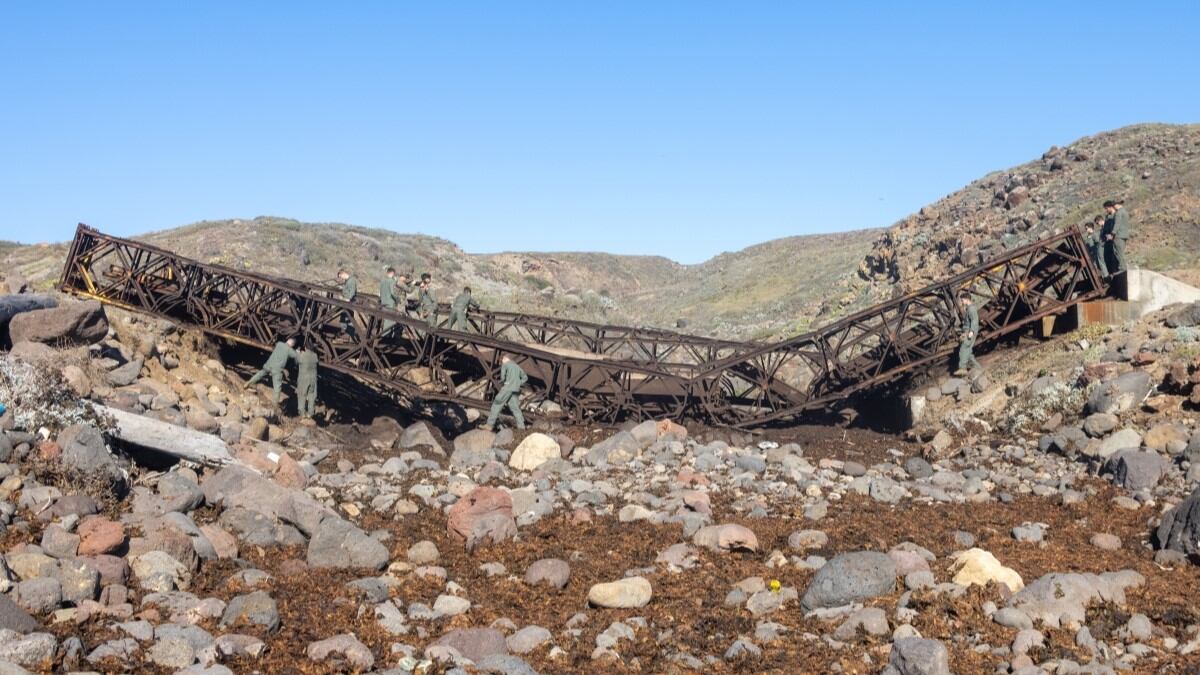Marines aren’t allowed to blow up a perfectly good bridge in the name of training. So they found a bad one.
The aviation ground support unit Marine Wing Support Squadron 373, based out of Miramar, California, demolished a hazardous 84-foot-long bridge on a California training ground beginning Jan. 5.
The Marines had been conducting a site survey to prepare for training on the island when they learned of the existence of the bridge, according to Marine spokeswoman Capt. Stephanie Leguizamon. For the squadron’s explosive ordnance disposal technicians and engineers, the bridge presented an unusual opportunity.
Marines from the unit said the purpose of the demolition was twofold: help fix up a military training area, and practice a skill that could prove useful in war.
The bridge had gotten rusty from the salt-filled air, to the point of being susceptible to collapse, according to Capt. Zach Adler, the squadron’s engineer company commander. The bridge had been the only way for vehicles to access a zone on San Clemente Island that is the only place on the West Coast the military can practice ship-to-shore bombardment, Adler said.
Benefits to the Navy-owned island aside, the demolition mission provided a rare training opportunity for Marines. Chief Warrant Officer 2 Austin Sabin, the squadron’s explosive ordnance disposal officer, said he had never heard of Marines in recent years blowing up a bridge of that size.
“Most owners of bridges don’t want them destroyed,” said Master Sgt. James Arbuthnot, the squadron’s explosive ordnance disposal chief.
First, Marines used explosives to destroy the bridge, according to Adler. Next it was up to civilian contractors to remove the pieces of the bridge that had fallen to the ground. Finally, in February, Marines will fill in the gap with earth, providing a crossing for vehicles.
The explosions took place from Jan. 5 to Jan. 7, Arbuthnot said. To down the bridge, the Marines first placed approximately 275 pounds of explosives at key points on the bridge and set them off. Then, with smaller explosions and welding, they broke up the bridge into easier-to-remove pieces.

The Marines were practicing a skill with battlefield applications, under conditions that approximated the ones Marines might face in a dispersed fight among Indo-Pacific islands, Adler said. As part of its ambitious overhaul aimed at countering China, the Marine Corps has adopted a concept called expeditionary advanced base operations, in which small groups of Marines lurk in temporary bases close to shore.
Instead of pretending to be surrounded by water while training in, say, the desert of Twentynine Palms, California, 16 Marines and one Navy corpsman actually were on an island, Adler noted.
They remained on San Clemente Island for days with a fixed supply of explosives and no cell phone service or communication equipment, Arbuthnot said. That meant the Marines had to make decisions based on the commander’s intent, rather than getting detailed guidance as the mission progressed — somewhat like how Marines might have to operate if stealthily positioned within reach of enemy fires.
In a real-world scenario, destroying a bridge could create an obstacle for enemy forces, making it harder for them to move troops and supplies, Sabin said.
In 1972, Marine Capt. John Ripley pulled off a daring mission to blow up the bridge at Dong Ha, South Vietnam, to stymie an advance by the North Vietnamese Army, a feat for which he would earn the Navy Cross.
The destruction of bridges has been a recurring tactic in the war between Russia and Ukraine, with Ukraine apparently mounting repeated attacks on the strategically important 12-mile bridge connecting Russia and Crimea.
“If you look historically at the impact and importance of bridges through major conflicts, all the way back to almost the ancient times, bridges were a key structure, every single time,” Sabin said.
Irene Loewenson is a staff reporter for Marine Corps Times. She joined Military Times as an editorial fellow in August 2022. She is a graduate of Williams College, where she was the editor-in-chief of the student newspaper.





